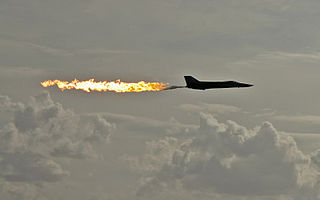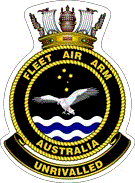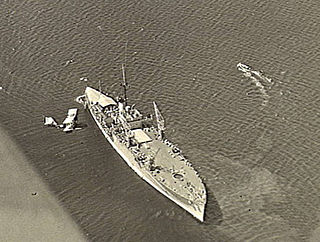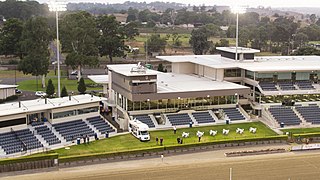
HMAS Melbourne (R21) was a Majestic-class light aircraft carrier operated by the Royal Australian Navy (RAN) from 1955 until 1982, and was the third and final conventional aircraft carrier to serve in the RAN. Melbourne was the only Commonwealth naval vessel to sink two friendly warships in peacetime collisions.

The 7th Carrier Air Group was an aircraft carrier air group of the Royal Navy's Fleet Air Arm. It was formed in June 1945, at HMS Nabthorpe, a Royal Navy Mobile Naval Operating Air Base (MONAB) at the Royal Australian Air Force (RAAF) base RAAF Station Schofields at Schofields, New South Wales, in Australia. The group was initially embarked on HMS Indefatigable (R10).
1790 Naval Air Squadron of the Fleet Air Arm of the Royal Navy was formed on 1 January 1945 at RNAS Burscough as a night fighter squadron. It was initially equipped with the Fairey Firefly I, replaced in May 1945 by the Firefly INF, which was fitted with a US-derived ASV radar. The squadron joined HMS Vindex on 24 June, bound for Australia, with the ship arriving at HMS Nabthorpe 2 days before the war in the Far East ended. The squadron was disbanded on 3 June 1946 at Devonport.

The Australian International Airshow, also called the Avalon Airshow, is a large air show held biennially at Avalon Airport, between Melbourne and Geelong in Victoria.

The Fleet Air Arm (FAA), known formerly as the Australian Navy Aviation Group, is the division of the Royal Australian Navy (RAN) responsible for the operation of aircraft. The FAA was founded in 1947 following the purchase of two aircraft carriers from the Royal Navy. FAA personnel fought in the Korean War and the Vietnam War, and participated in later conflicts and operations from host warships.

HMAS Albatross was a seaplane tender of the Royal Australian Navy (RAN), which was later transferred to the Royal Navy and used as a repair ship. Albatross was built by Cockatoo Island Dockyard during the mid-1920s and entered service at the start of 1929. The ship experienced problems with the aircraft assigned to her during her career: the amphibious aircraft she had been designed for were retired just before the ship entered service, the replacement aircraft could not be catapult-launched from the ship, and a new plane designed specifically to work with the ship began operations after Albatross was demoted from seagoing status in 1933.

HMAS Albatross is the main naval air station for the Royal Australian Navy's (RAN) aviation branch, the Fleet Air Arm. The base, located near Nowra, New South Wales, was formally established in May 1942 as Royal Australian Air Force (RAAF) base RAAF Nowra, then was transferred to the Royal Navy as HMS Nabbington in 1944, and operated as a naval air station until it was decommissioned in late 1945. In 1948, the airfield was commissioned into the RAN as HMAS Albatross, as the primary shore base for the Fleet Air Arm. Since 2011, five squadrons of the Fleet Air Arm operate from Albatross. The current commander of the base is Captain Robyn Phillips, RAN.
Jervis Bay Airfield is a military aerodrome in the Jervis Bay Territory in Australia. It is the only aerodrome in the territory and is located about 10 km (6.2 mi) east of Sussex Inlet; and about 2 km (1.2 mi) south of Jervis Bay Village and HMAS Creswell.

No. 9 Squadron is a unit of the Royal Australian Air Force (RAAF). The squadron was formed in early 1939 and saw active service in World War II as a fleet co-operation unit providing aircrews for seaplanes operating off Royal Australian Navy cruisers. It was disbanded in late 1944, but was re-raised in 1962 and later became an Army co-operation unit, flying helicopters in support of Australian troops during the Vietnam War. The squadron was disbanded in 1989 when the RAAF transferred its battlefield helicopters to the Australian Army's aviation regiments. It was re-raised in June 2023 to operate Northrop Grumman MQ-4C Tritons.

The Supermarine Seagull was a flying boat produced by the British aircraft manufacturer Supermarine. It was developed by Supermarine's chief designer R.J. Mitchell from the experimental Supermarine Seal II.

No. 101 Flight RAAF was a Royal Australian Air Force fleet co-operation flight equipped with amphibian aircraft. The flight was formed on 1 July 1925, and operated from the Royal Australian Navy seaplane tender HMAS Albatross between 1929 and 1933. After Albatross paid off the flight's aircraft operated from the RAN's heavy cruisers HMAS Australia and HMAS Canberra. No. 101 Flight was expanded to form No. 5 Squadron on 20 April 1936.
HMAS Nirimba is a former Royal Australian Navy (RAN) training base located at the former RAAF Station Schofields at Nirimba Fields, previously Schofields, in Sydney, New South Wales, Australia.
HMS Nabberley was a Royal Navy Mobile Operational Naval Air Base (MONAB) at the Royal Australian Air Force (RAAF) base RAAF Bankstown at Bankstown, New South Wales, Australia. HMS Nabberley was also known as MONAB II and Royal Naval Air Station Bankstown.
HMS Nabthorpe was a Royal Navy Mobile Naval Operating Air Base (MONAB) at the Royal Australian Air Force (RAAF) base RAAF Station Schofields at Schofields, New South Wales. HMS Nabthorpe was also known as MONAB III and Royal Naval Air Station (RNAS) Schofields.
Admiral Sir Victor Alfred Trumper Smith, was a senior officer in the Royal Australian Navy. Smith's career culminated with his appointment as chairman, Chiefs of Staff Committee—forerunner of the role of Australia's Chief of the Defence Force—from 1970 to 1975, following an earlier term as Chief of Naval Staff from 1968 to 1970.

808 Naval Air Squadron is a ship-based helicopter squadron of the Royal Australian Navy.

Menangle Park Paceway, known for sponsorship reasons as Tabcorp Park, Menangle, is a harness racing track operating in Menangle Park, New South Wales, Australia. The New South Wales Harness Racing Club conducts meetings at the Paceway. The New South Wales Harness Racing Club trading as Club Menangle Trackside is located within the Paceway grounds. Major extensions to the club at the licensed historic premises previously known as the Horse and Jockey Inn just outside the paceway grounds, opened in September 2019.

The first involvement Australia had with naval aviation was in 1911, when an Australian-born Royal Navy officer became one of the first four naval officers to receive pilot qualifications. During World War I, the Royal Australian Navy (RAN) experienced several forms of airborne operation, with HMAS Brisbane operating a seaplane, while HMA Ships Sydney and Australia were used for experiments with aircraft launch platforms. An aircraft embarked aboard Sydney was also involved in one of the first naval air battles. Several Australians also flew as part of the Royal Naval Air Service.
Nirimba Fields is a suburb of Sydney in the state of New South Wales, Australia. Nirimba Fields is in north-west Sydney in the local government area of Blacktown. Nirimba is a Dharug word meaning pelican.












